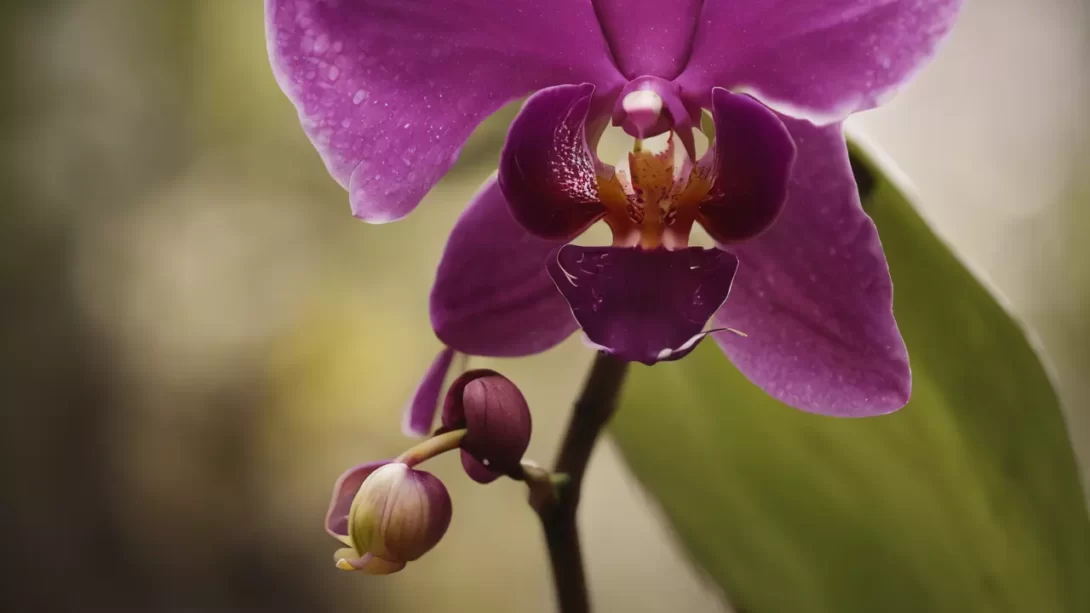Orchids, with their captivating blooms and delicate elegance, have become a cherished addition to many indoor gardens. As any orchid enthusiast knows, these plants can be a bit finicky, requiring specific care to flourish. One common concern that leaves orchid owners perplexed is the wilting of their orchid leaves. If you’ve noticed your orchid’s once vibrant leaves starting to droop, fear not – in this article, we delve into the various reasons behind orchid leaf wilting and provide practical solutions to revive your prized plant.
- Gold Standard Orchid Fertilizer. Trusted by Botanic Gardens, Professionals, and Hobbyists Growers.
- Urea Free Orchid Food. Gentle Formulation Perfect for Any Orchid or Houseplant.
- Recommended for use with reverse osmosis (RO), rain or tap water low in alkalinity
- Instructions for use included on label
- Official rePotme Product – Sponsor of Popular Channels like MissOrchidGirl, Tanner the Planter, Nick Pilleggi, and More!
Normal Leaf Behavior
Before diving into the potential causes of wilting, it’s crucial to understand the normal behavior of orchid leaves. Orchids, like all plants, undergo a natural process of shedding older leaves as part of their growth cycle. This shedding is a normal occurrence, and it doesn’t necessarily indicate a problem with the plant. Recognizing this natural behavior will help you distinguish between the normal shedding of older leaves and abnormal wilting that might be a cause for concern.
Inadequate Watering
One of the most common culprits behind orchid leaf wilting is inadequate watering. Orchids are particularly sensitive to changes in moisture levels, and both underwatering and overwatering can have detrimental effects. In the case of underwatering, orchid leaves may become wrinkled and dry, lacking the turgidity that characterizes a healthy plant. On the other hand, overwatering can lead to yellowing and a soft, soggy texture in the leaves.
Achieving the right balance is key. Orchids typically prefer a moist but not waterlogged environment. Regularly check the moisture content of the growing medium and adjust your watering frequency accordingly. Remember, orchids often fare better when the roots experience a cycle of drying out slightly between waterings. In the upcoming sections, we will explore other potential causes of orchid leaf wilting and offer solutions to help you nurture your orchid back to health.
Light Issues
Proper light conditions are vital for the well-being of orchids. Inadequate light exposure can contribute to orchid leaf wilting. Orchids generally thrive in bright, indirect light. If your orchid is not receiving enough light, you may notice symptoms such as pale leaves and a reluctance to bloom. On the other hand, excessive light can lead to scorched leaves and, in some cases, wilting.
To address light issues, carefully assess the location of your orchid. Ensure it is placed in a spot where it receives the right balance of light – bright but filtered. If natural light is insufficient, consider supplementing with artificial light sources specifically designed for orchids. Regularly rotating the orchid to ensure even light exposure on all sides can also be beneficial.
Potting Mix and Container Issues
The health of an orchid is intricately tied to its potting mix and container. Over time, the potting mix can become compacted, affecting water drainage and the overall well-being of the roots. A deteriorated or broken-down mix may not provide the necessary aeration for the roots, leading to stress and wilting.
Regularly inspect the condition of the potting mix and consider repotting your orchid if the mix appears compacted or has started to break down. When repotting, choose a well-draining mix designed for orchids, and ensure the container has adequate drainage holes. The right potting mix and container combination can significantly contribute to the health of your orchid, preventing issues like root rot and subsequent leaf wilting.
- 💓 ALL PURPOSE MIX — Made with Charcoal, Sponge Rock, Pine Bark, Coconut Chips
- 🔗 ROOTS CAN CLIMB — Orchid Roots love to climb and expand, this textured mix allows them to stretch to their full potential
- 🌬 AERATION — Mix does not compact or suffocate orchid roots
- 💧 DRAINAGE — Orchids do not require frequent waterings but do require proper drainage, too much water can kill your orchid plant
- 🔩 HEAVY DUTY, RE-SEALABLE BAG — Perfect for storage or later use
Humidity Levels
Orchids are known for their affinity for higher humidity levels, and insufficient humidity can contribute to leaf wilting. In environments with dry air, especially during winter or in air-conditioned spaces, orchids may struggle to retain moisture, resulting in wilting leaves. Signs of low humidity also include shriveled pseudobulbs and a general lack of turgidity in the leaves.
To address humidity concerns, consider increasing ambient humidity around your orchid. This can be achieved by placing the orchid on a humidity tray filled with water and pebbles, using a room humidifier, or grouping plants together to create a microclimate. Additionally, avoid placing orchids near drafts or heating/cooling vents, as these can exacerbate humidity issues.
By addressing light, potting mix, and humidity concerns, you’ll be well on your way to creating an optimal environment for your orchid. In the next sections, we will explore potential issues related to disease, pests, and temperature extremes that could also contribute to orchid leaf wilting.
Disease and Pests
Orchids, while resilient, are not immune to diseases and pests that can lead to leaf wilting. Common issues include fungal infections, bacterial diseases, and infestations by pests like aphids or spider mites. Symptoms may include yellowing, spots, or abnormal growth patterns in addition to wilting.
Regularly inspect your orchid for any signs of disease or pests. Isolate affected plants to prevent the spread of issues to healthy ones. Treatments may include applying fungicides or insecticidal soaps, depending on the specific problem. Ensure good airflow around the orchid to discourage the development of fungal conditions. Vigilance and prompt action are key to managing disease and pest-related wilting effectively.
Temperature Extremes
Extreme temperatures, whether too hot or too cold, can stress orchids, leading to leaf wilting. Orchids generally prefer temperatures between 60°F to 80°F (15°C to 27°C). Exposure to temperatures outside this range can result in visible distress. Cold temperatures can cause chilling injury, while excessive heat can lead to wilting and sunburn.
Protect your orchid from temperature extremes by maintaining a suitable environment. Avoid placing orchids near drafts, windows, or heating/cooling sources that can subject them to abrupt temperature changes. In colder climates, take precautions to shield orchids from frost, and in warmer climates, provide adequate shading during intense sunlight.
Conclusion
Understanding the reasons behind orchid leaf wilting is a crucial step in restoring your plant to its full health and beauty. Whether it’s due to inadequate watering, light issues, potting mix concerns, humidity levels, diseases, pests, or temperature extremes, a careful and methodical approach to orchid care is essential.
Regular monitoring, adjusting care practices based on your orchid’s specific needs, and prompt intervention when issues arise will contribute to the overall well-being of your orchid. Remember that orchids are resilient plants, and with proper care, they can recover from wilting, producing vibrant blooms and lush foliage once again. By combining knowledge with attentive care, you can enjoy the continued elegance and grace of your cherished orchids.





